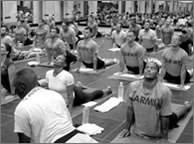 The greatest gifts of yoga for me have been the reduction of suffering in my life and the ability to experience joy. On a physical level, I have experienced pain from problems with my spine, which my yoga practices have helped me to manage so they do not debilitate me. But my greatest vulnerability has been a susceptibility to anxiety and depression. At its worst, I experienced panic attacks and debilitating depression.
The greatest gifts of yoga for me have been the reduction of suffering in my life and the ability to experience joy. On a physical level, I have experienced pain from problems with my spine, which my yoga practices have helped me to manage so they do not debilitate me. But my greatest vulnerability has been a susceptibility to anxiety and depression. At its worst, I experienced panic attacks and debilitating depression.
After I began practicing yoga, about twenty years ago, I started noticing a change. As I continued with yoga, the panic attacks went away. At the time, this amazed me. Of course, now I know that yoga can induce the relaxation response, the body’s natural way of counteracting the stress response, which is at the heart of panic attacks. But while the panic attacks disappeared, I still experienced free-floating anxiety and cycles of depression.
Over the last ten years, as I have worked with my teachers, done a regular yoga practice, and studied the teachings of yoga, I have experienced a more profound healing. It is not that everything has disappeared. Instead, I have become more aware, and, with this awareness, I have had insights into the patterns of thinking that led me to feeling anxious and depressed. My teacher has taught me tools from yoga that helped me to move my mind to a more positive space when I was worried or felt myself in a negative or fearful spiral of thinking. As I have continued to study, my insights and understanding have grown, and so has my ability to make changes in old negative patterns and to create new positive patterns that support my life.
The teachings of yoga guide my life. The Yoga Sutra, yoga’s most important text, has helped me understand how the mind works, and that has helped me greatly with self-understanding and acceptance. As well as insight, the Yoga Sutra also gives me answers – how I can change from where I am to a place of greater clarity and peace, which ultimately is the source of joy.
We all have vulnerabilities. For some of us, it is a physical issue, like back pain or neck strain that reoccurs; for some it may be asthma, for others high blood pressure, migraines, anxiety, or an eating disorder. While yoga does not claim to cure all these maladies, it offers many tools to support our healing. As we practice regularly, over time, with the guidance of a teacher, we can find our suffering reduced and our hearts open to the joy that lies within us.
~
 The experience of loss is always about change – struggling with and finally accepting change on many levels. Yoga, as a discipline and a philosophy, is also about acceptance of what is – of who we are, of the situation we are in, and of the circumstances that brought us to this point. Through the physical and mental practice that is yoga we can learn to apply principles of acceptance to all areas of life.
The experience of loss is always about change – struggling with and finally accepting change on many levels. Yoga, as a discipline and a philosophy, is also about acceptance of what is – of who we are, of the situation we are in, and of the circumstances that brought us to this point. Through the physical and mental practice that is yoga we can learn to apply principles of acceptance to all areas of life. In my Wednesday night
In my Wednesday night 
 The greatest gifts of yoga for me have been the reduction of suffering in my life and the ability to experience joy. On a physical level, I have experienced pain from problems with my spine, which my yoga practices have helped me to manage so they do not debilitate me. But my greatest vulnerability has been a susceptibility to anxiety and depression. At its worst, I experienced panic attacks and debilitating depression.
The greatest gifts of yoga for me have been the reduction of suffering in my life and the ability to experience joy. On a physical level, I have experienced pain from problems with my spine, which my yoga practices have helped me to manage so they do not debilitate me. But my greatest vulnerability has been a susceptibility to anxiety and depression. At its worst, I experienced panic attacks and debilitating depression.